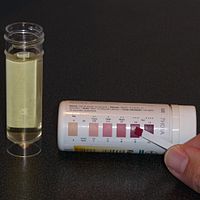
Photo from wikipedia
Simple Summary The fall armyworm (Lepidoptera: Noctuidae) is one of the main pests of corn and cotton in South American countries, but it can also feed and survive on castor… Click to show full abstract
Simple Summary The fall armyworm (Lepidoptera: Noctuidae) is one of the main pests of corn and cotton in South American countries, but it can also feed and survive on castor bean. These plants are cultivated in Brazil in an intercropping and/or succession system in small and large rural properties, at different times of the year near to each other, what can facilitate the movement of this pest and make it difficult to control. The results obtained are promising and confirm our hypothesis that the consumption of host crops less suitable for the fall armyworm can impair its development, survival and reproduction, reducing its infestation in the next host. Abstract The polyphagy of Spodoptera frugiperda (Lepidoptera: Noctuidae) renders its control difficult because variations in the phenology of host plants grown in different seasons of the year and near each other can facilitate the movement of this pest between crops. The objective of this work was to examine certain biological characteristics of S. frugiperda fed on an artificial diet or on cotton, castor bean, or corn leaves. The experimental design was in randomized blocks, with four treatments represented by S. frugiperda caterpillars fed an artificial diet (T1) or pieces of cotton (T2), castor bean (T3) or corn (T4) leaves with five replications (five caterpillars per replication). The duration and survival of the egg, larva, pre-pupa, pupa and egg-adult period and the reproductive characteristics of this insect were determined. The survival, development and reproduction data of S. frugiperda originated from individuals reared with cotton and castor bean leaves were lower than those fed on corn leaves or an artificial diet. The number of nonviable eggs laid by females originated from caterpillars fed on castor bean leaves was higher than those fed on cotton and corn leaves or an artificial diet. The very higher number of unviable S. frugiperda eggs resulting from castor leaves can reduce outbreaks of this pest in cotton and corn crops after the cultivation of that plant, or by intercropping with this plant, in the main producing regions of Brazil.
Journal Title: Insects
Year Published: 2022
Link to full text (if available)
Share on Social Media: Sign Up to like & get
recommendations!